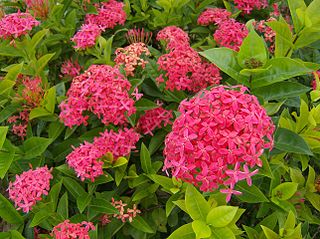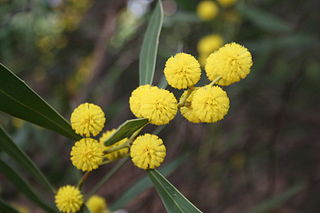
The Rubiaceae are a family of flowering plants, commonly known as the coffee, madder, or bedstraw family. It consists of terrestrial trees, shrubs, lianas, or herbs that are recognizable by simple, opposite leaves with interpetiolar stipules and sympetalous actinomorphic flowers. The family contains about 13,500 species in about 620 genera, which makes it the fourth-largest angiosperm family. Rubiaceae has a cosmopolitan distribution; however, the largest species diversity is concentrated in the tropics and subtropics. Economically important species include Coffea, the source of coffee, Cinchona, the source of the antimalarial alkaloid quinine, some dye plants, and ornamental cultivars.

Macrozamia is a genus of around forty species of cycads, family Zamiaceae, all of which are endemic to Australia. Many parts of the plant have been utilised for food and material, most of which is toxic if not processed correctly.

Berberidopsis is a genus of flowering plants in the small family Berberidopsidaceae.

Archirhodomyrtus is a genus of flowering plants in the myrtle family, Myrtaceae, describe as a genus in 1941. There are five known species, four native to New Caledonia and one native to Australia.

Ixora is a genus of flowering plants in the family Rubiaceae. It is the only genus in the tribe Ixoreae. It consists of tropical evergreen trees and shrubs and holds around 562 species. Though native to the tropical and subtropical areas throughout the world, its centre of diversity is in Tropical Asia. Ixora also grows commonly in subtropical climates in the United States, such as Florida where it is commonly known as West Indian jasmine. Other common names include viruchi, rangan, kheme, ponna, chann tanea, techi, pan, siantan, jarum-jarum/jejarum, jungle flame, jungle geranium, and cruz de Malta, among others. The plants possess leathery leaves, ranging from 3 to 6 inches in length, and produce large clusters of tiny flowers in the summer. Members of Ixora prefer acidic soil, and are suitable choices for bonsai. It is also a popular choice for hedges in parts of South East Asia. In tropical climates they flower year round and are commonly used in Hindu worship, as well as in ayurveda and Indian folk medicine.

Ixora coccinea is a species of flowering plant in the family Rubiaceae. It is a common flowering shrub native to Southern India, Bangladesh, and Sri Lanka. It has become one of the most popular flowering shrubs in South Florida gardens and landscapes. It is the national flower of Suriname.

Leionema is a genus of more than 20 species of mostly small shrubs in the family Rutaceae, most of which are endemic to eastern Australia. Plants within this genus have scented foliage and clustered, star-shaped flowers which range in colour from cream to bright yellow. Prior to 1998, all species within this genus were included in the genus Phebalium.

Papillilabium beckleri, commonly known as the imp orchid, is the only species in the genus Papillilabium from the orchid family, Orchidaceae. It is a small, epiphytic orchid with many thin roots, between two and six linear leaves and up to eight pale green or brownish flowers. The flowers are fragrant, produce nectar and have a warty labellum. It grows on shrubs and trees in humid places and near streams and is found between south-east Queensland and the Sydney region in New South Wales.

Telopea aspera, commonly known as the Gibraltar Range waratah, is a plant in the family Proteaceae. It grows as a woody shrub to 3 metres (10 ft) high with leathery rough leaves and bright red flower heads known as inflorescences—each composed of hundreds of individual flowers. It is endemic to the New England region in New South Wales in Australia. It was formally described as a species by botanists Peter Weston and Mike Crisp in 1995, separated from its close relative Telopea speciosissima by its rough foliage and preference for dryer habitat. Unlike its better known relative, Telopea aspera has rarely been cultivated.

Leionema elatius, commonly known as tall phebalium, is a shrub species that is endemic to New South Wales and Queensland in Australia. It has glossy green, variably-shaped leaves and clusters of white-lemon flowers in spring.

Grevillea irrasa is a shrub species which is endemic to New South Wales in Australia. It has a spreading to erect habit, growing 1.5–3 metres high. Flowers appear between August and January in its native range. These are red, apricot or pink.
Grevillea epicroca is a shrub species that is endemic to south-eastern New South Wales in Australia. It grows up to 2.5 metres high and produces clusters of red flowers between November and May in the species' native range. It was first formally described by Val Stajsic and Bill Molyneux, their description published in Flora of Australia in 2000.

Lomatia myricoides, commonly known as the river lomatia, is a shrub native to New South Wales and Victoria in southeastern Australia.

Acacia beckleri, or Barrier Range wattle, is a plant in the genus Acacia native to Australasia, typically Australia. It is named after Dr Hermann Beckler, the botanist on the Burke and Wills expedition in 1861 and it was he who collected the type specimen. The common name refers to the Barrier Range in the Broken Hill area, western New South Wales. This species is similar to A. notabilis and A. gladiformis.

Acacia notabilis, known colloquially as mallee golden wattle, Flinders wattle or stiff golden wattle, is a species of Acacia native to Australia.

Arthropteris beckleri is a small rainforest fern of the genus Arthropteris native to eastern Australia. It is found north of Nowra, usually growing on rocks or from trees in areas of high altitude.

Grevillea ramosissima, commonly known as fan grevillea, is a shrub species of the family Proteaceae. It is native to south-eastern Australia.

The National Herbarium of New South Wales was established in 1853. The Herbarium has a collection of more than 1.4 million plant specimens, making it the second largest collection of pressed, dried plant specimens in Australia, including scientific and historically significant collections and samples of Australian flora gathered by Joseph Banks and Daniel Solander during the voyage of HMS Endeavour in 1770.

Berberidopsis beckleri is a species of climbing plant found in cool rainforests in eastern Australia. Ferdinand von Mueller described the plant as Streptothamnus beckleri from collections at the Clarence River.

Dr. Hermann Beckler was a German doctor with an interest in botany. He went to Australia to collect specimen for Ferdinand von Mueller and served as medical officer and botanist for the Victoria Exploring Expedition in 1860.


















